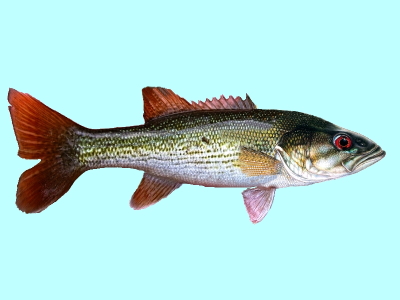|
|
Freshwater Fish Species
The black bass family of the sunfish species
Saltwater Fish Species
Redeye Bass Fish Identification, its habitats, characteristics, fishing methods.
The Redeye Bass is one of the scrappy fighting fresh water fish that hard to catch. They also highly considered on the dinner table with their white, flaky meat. The most interesting that the very basic (pole with worm) are still extremely effective. To do well in bass fishing, the best way is to study the creature, where it lives, what environment and water temperatures they prefer, what type of bait or lure better to use.
Bass loves to be over sheltered areas where old trees are under the water are used by smaller fish as a cover. The Redeye Bass feed on red worms, leaf worms, night crawlers, larval insects, crayfish and small fishes. It can be caught on all types of artificial baits, from under water spinners and spoons to top water lures. More knowledge about the Redeye Bass can surely help you to increase your catch. Better knowing and understanding the bass feeding and spawning habits will make you a more successful angler and will help to catch them considerably.

|
The Redeye bass Micropterus coosae is a freshwater fish in the
Sunfish family, also known as Coosa bass, shoal bass, Flint River smallmouth, Chipola bass, black bass. One of the
Black basses, it is native to only a few rivers in western South Carolina, southwestern North Carolina, eastern Tennessee, and portions of Georgia, Alabama, and streams in central Kentucky.
|
Description
The Redeye bass (Coosa bass) have an elongate, slender body with a large mouth that extends to the rear margin of the eye. The upper jaw (maxillary) extends to the back of the red eye. The red color of eyes and fins easily separates this species from other bass. The tongue has a small tooth patch. They have 9 to 11 (usually 10) dorsal fin spines and 11 to 13 (usually 12) rays with the only a little notched area between them (first and second dorsal fins are clearly connected). The anal fin has 3 spines and 9 to 11 (usually 10) rays. The whole lateral line has from 63 to 74 scales. They also have 12 to 13 scales above the lateral line and 26 to 30 scale rows around the caudal peduncle.
The back and sides are brownish to greenish in color with vertical bars. Light centers along their sides and are bronze-olive above, dark olive mottling, yellow-white to blue below. Adults have few horizontal rows of dark spots on the lower sides and gill cover. Breeding males have a light bluish green color on the lower head and throat. Young have 10 to 12 dark blotches lighter color in the center on the sides of the body that do not join together to form a lateral stripe. The upper and lower margins of the caudal fin are edged in white, a useful feature for separating redeye bass from both
Smallmouth Bass and
Shoal Bass.
Suwannee Bass and
Shoal
also have red eyes but normally have much less red on fins.
The redeye bass is one of the smaller black basses, growing to a maximum length of 19 in (47 cm). The growth rate of redeye bass is slow when compared to other species of Black basses. Growth is fast the first year but decreases as the fish becomes older. Shoal bass grow much faster than redeye bass.
Habitat and Habits
The redeye inhabits small to medium rivers that are close to main-channel, upland streams and very rarely large rivers, natural lakes, pond or impoundments. They prefer a water temperature of about 65 degrees, often found in water near a submerged stump or rock, or along an undercut bank near the aquatic vegetation. Young occur in shallow runs and riffles over sand and gravel bottom. Redeye bass feed mainly on aquatic and terrestrial insects on the surface. They also feed on larval insects, crayfish and small fishes.
Spawning
Redeye bass spawn in coarse gravel at the heads of creek pools from April to early July. They never spawn in ponds or lakes. Redeye prefers spawning temperature from 62 to 69 degrees. They build nests in hard-bottom areas next to shallow shorelines or in protected areas such as canals and heavy aquatic vegetation coves. The male builds saucer-shaped nests 20 to 30 inches in diameter by placing its lower jaw near the bottom and rotating around this central location.
After spawning from 5 to 10 days, the male guards the nest and eggs. The female bass usually stays near the nest sometimes swim a short distance for food. After hatching, the fry swim in tight schools.
Fishing Methods are spin-casting, still fishing, Bait-casting and pole fishing. The redeye is good game fish and a scrappy fighter that makes it hard to catch. They can be caught on worms, minnows, or crayfish as well as small spinners and a wide variety of small surface lures. They are good eating quality, have white, flaky meat a little drier than of a largemouth.
Great rods for Redeye bass fishing are:
24ft Telescopic Fishing Pole
21ft Fishing Pole made of 99% Carbon
18ft Telescopic Carbon Pole
12ft Telescopic Fishing Hera Rod
18ft Telescopic Spinning Rod
12ft Telescopic Spinning Rod
12ft Telescopic Casting Light Rod
|
|
|

